“The Devil in the Dark”
Written by Gene L. Coon
Directed by Joseph Pevney
Season 1, Episode 26
Production episode 6149-26
Original air date: March 9, 1967
Stardate: 3196.1
Captain’s log. In the pergium production facility on Janus VI, a group of miners are engaged in an armed search, trying to find the thing that has already killed fifty people. Chief Engineer Vanderberg leads a team to relieve one guard, leaving behind another, Schmitter. Schmitter is understandably nervous, though Vanderberg reassures him that the Enterprise is on its way.
Only a minute after Vanderberg and the others walk away, Schmitter is attacked by something, and burned to a crisp.
The Enterprise arrives, and Kirk, Spock, and McCoy beam down. Vanderberg fills them in: three months ago, they opened a new level for mining, and suddenly equipment started disintegrating. Then the engineers sent to repair the machines were killed. The deaths have continued, now happening at higher and higher levels. The only one who has seen it and survived is Ed Appel, one of the engineers, who shot it with a phaser, but it had no effect. He only got a glimpse of it, describing it as “shaggy.” Sensors detect no life aside from the colonists.
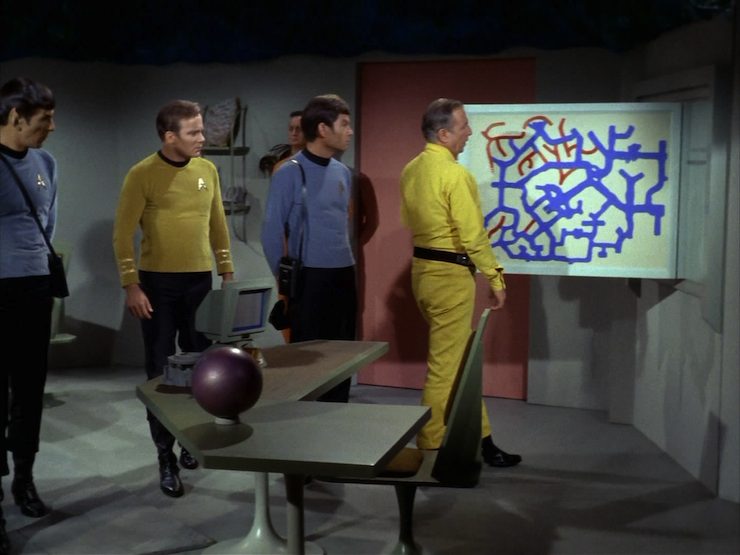
At this point, production has ceased until the issue is resolved, which is the Enterprise‘s job.
Spock also notices a silicon sphere on Vanderberg’s desk. He says they’ve found tons of them on the lower levels—almost pure silicon, but no real value, though Spock thinks they’re geologically quite impressive.
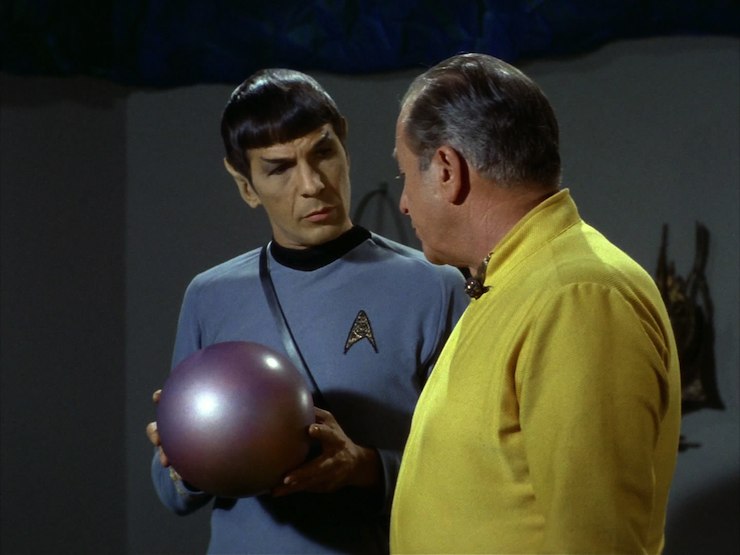
McCoy examines Schmitter’s body and reports that he wasn’t burned to death, but rather was exposed to a corrosive agent, probably some kind of powerful acid, strong enough to eat through machinery, or pretty much anything else.
Near the power reactor, another person is killed, and the creature enters the reactor room by dissolving the reactor door. A circulating pump has also been removed, one critical to the production plant’s life support system—but also a very old, outdated piece of equipment that they have no replacements for on the colony or on the Enterprise. Kirk orders Scotty to cobble together something, but the best he can do is a patch that will only hold for a couple of days.

This latest attack proves the creature is intelligent, and is trying to drive away the humans. Spock theorizes that the creature could be a silicon-based life form that lives deep under the surface. He also notes that the spheres were found on the same level that the attacks started.
Scotty installs the patch on the pump. A security team has also beamed down, led by Lieutenant Commander Giotto. Kirk sends them to search for the creature, starting on Level 23, which is where the silicon spheres were found. Kirk and Spock search as well, the latter having adjusted his tricorder to seek out silicon.
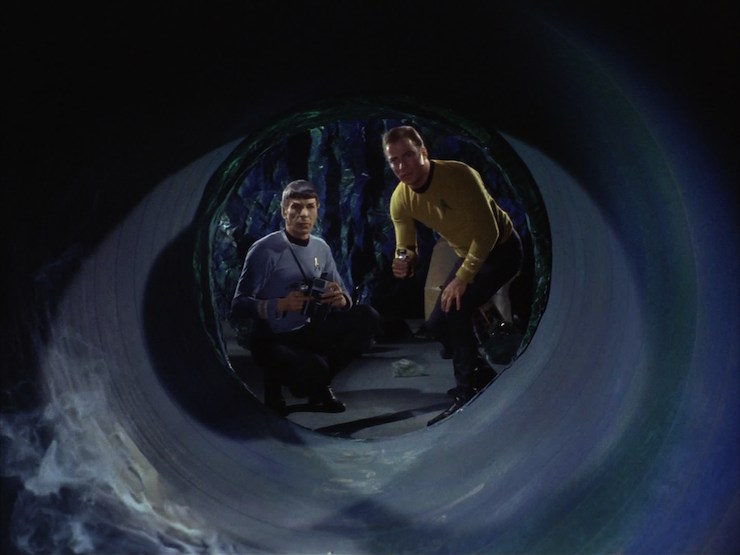
One of the guards is attacked and killed by the creature, attacked so quickly that the guard never had a chance to fire his phaser. Nearby is a tunnel that isn’t on the plans, and Spock says was made within the last hour.
The creature then appears behind them. They fire on it, and it retreats—through the wall, using the corrosive that it’s used to kill people to dissolve the rock. The creature is gone quickly, but the phaser fire knocked off a piece of it.
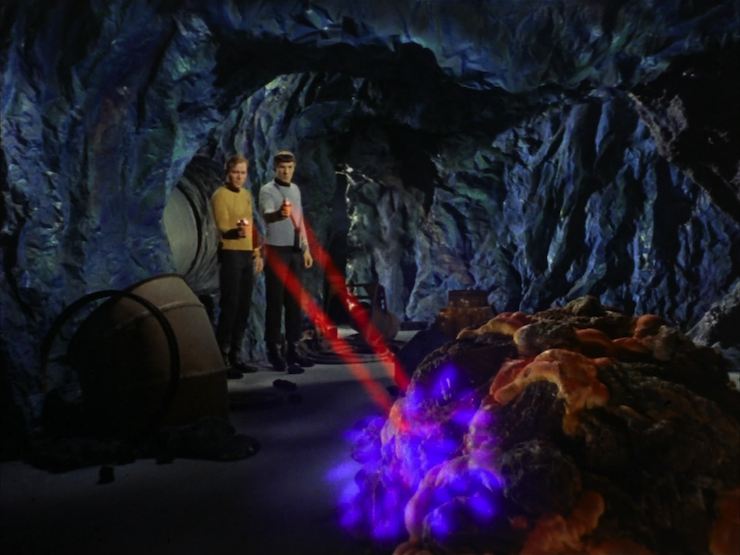
Kirk sends Giotto to continue the search, but tells him to be careful, as a wounded animal is even more dangerous, and to maintain phaser fire with significant duration. Spock has only detected one life form moving through the rock, and Spock is concerned that this may be the last survivor of a species.
Scotty’s improvised pump has failed, so the colony has ten hours before the air becomes unbreatheable. Most of the colony is evacuated, with only Vanderberg and a few others staying behind to supplement the Enterprise security detail.
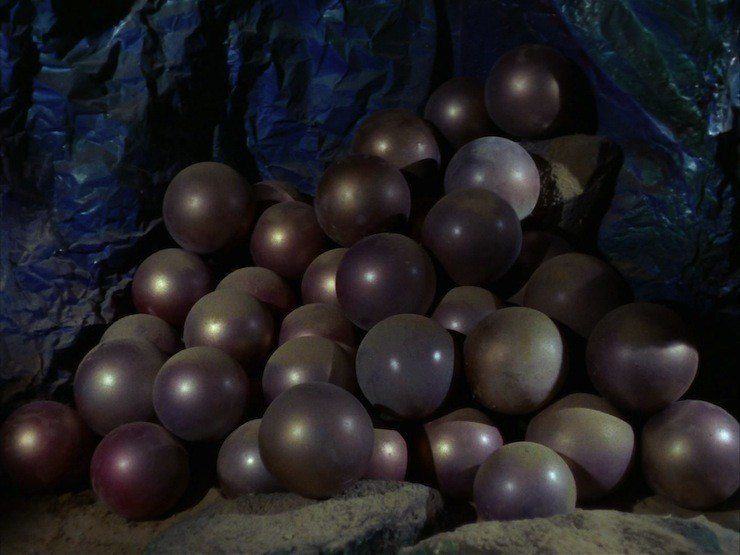
Kirk and Spock find a whole mess of the silicon spheres in what looks like a stockpile—and then also the creature. It responds to Kirk holding up his phaser, keeping its distance. It also moves to stand between Kirk and the spheres.
Spock suggests a mind-meld with the creature. He believes that the creature is protecting the spheres, and Kirk agrees, and so Kirk goes along with the suggestion.
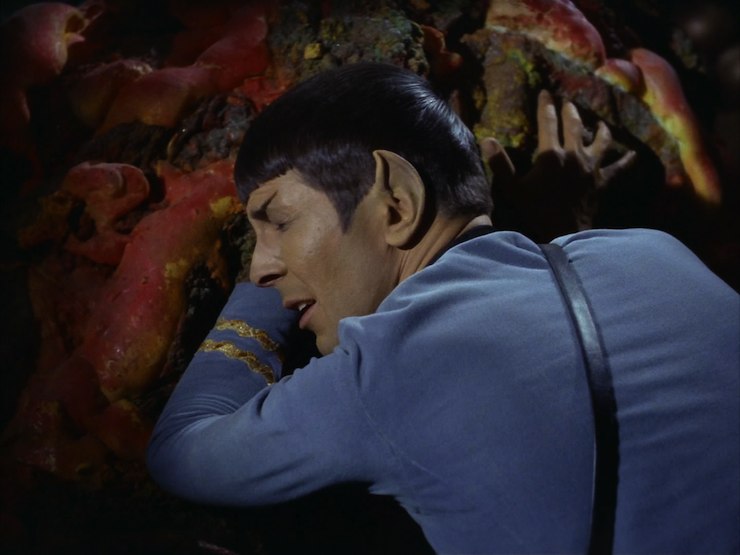
The meld is difficult and painful (we know this because Spock cries out, “PAIN!” a lot), and after breaking the link, Spock explains that the creature is the one in pain, from the wound.
But apparently it got something from the meld, too, as it etches the words “NO KILL I” in the rock in English. Spock also verifies that the creature is intelligent, calling itself a Horta.
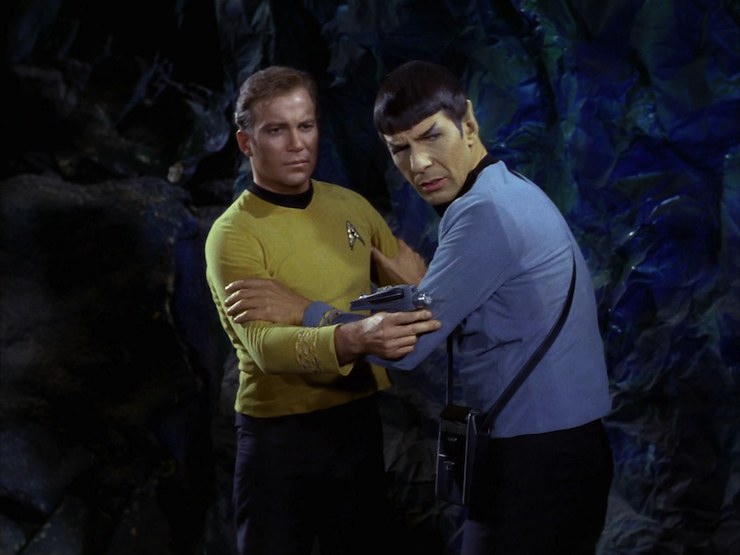
Kirk summons McCoy, hoping he can heal the Horta of its wound as a gesture of good faith. McCoy himself is skeptical, but does what he can, using a high-tech concrete that is mostly silicon, which does the trick. Meanwhile, Spock tries the meld again, and learns—through metaphorical language that he speaks in a histrionic voice—that the spheres are eggs. She is the mother of a new generation of Horta, and the miners killed thousands of her children when they unthinkingly destroyed some of the spheres. Kirk finds the missing pump, still intact.
The miners are less interested communication and more interested in revenge for their murdered comrades, and they beat up Giotto and his people and storm the cavern. But they’re brought up short when Kirk reveals that the “monster” was a mother protecting her children after thousands of them were killed.
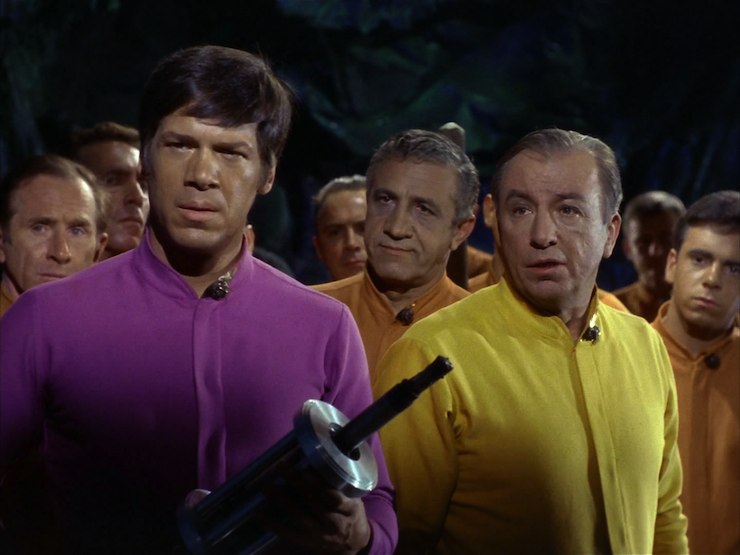
Kirk proposes a compromise: work with the Horta. They move through the rock like air and make tunnels, the miners can then collect the minerals needed. The Horta are peaceful, normally, and only acted as she did after the eggs were destroyed.
The Horta agrees, and the eggs hatch, thus leading to the beginning of a beautiful friendship.
Fascinating. Spock mind-melds with the Horta in order to learn the truth. He later reveals that she found humanoids generally repulsive, but that Spock’s ears were, at least, aesthetically pleasing. At least, that’s what Spock claimed…
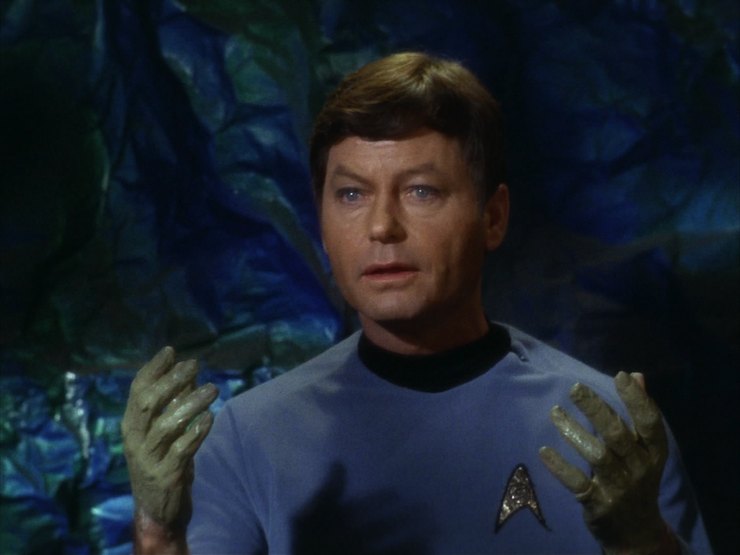
I’m a doctor not an escalator. A catchphrase is born! This episode is the first instance of the famous “I’m a doctor, not a ______” construction, with the blank being filled with “bricklayer” by McCoy when he’s confronted with the notion of healing a silicon-based life form. However, despite his complete skepticism early on regarding even the possibility of silicon-based life, he does heal the Horta. Because he’s just that awesome.
I cannot change the laws of physics! Scotty laughs when Kirk asks if he can fix the pump, as he hasn’t even seen one of that model for twenty years. But he manages to make a temporary patch. Because he’s just that awesome.
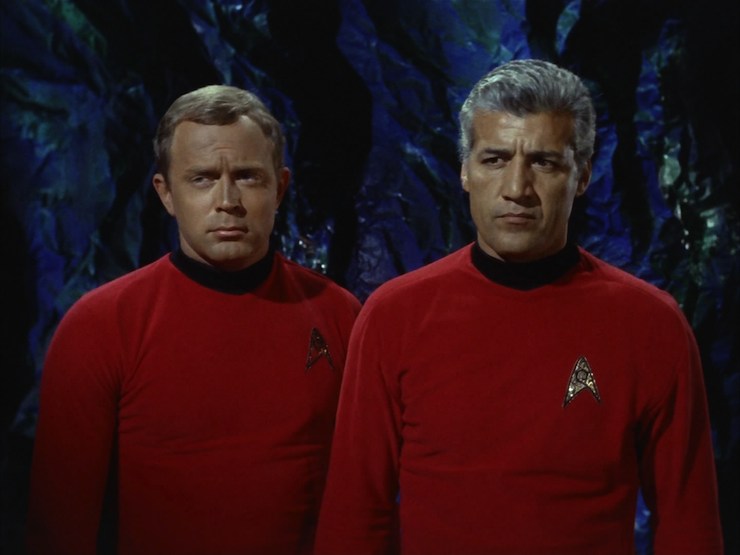
Go put on a red shirt. We actually get to see the Enterprise‘s chief of security, but he mostly just takes Kirk’s orders and never asks about the guard who was killed (who only gets a mild look of concern from Kirk after he’s killed—though the expression on William Shatner’s face is such that he could just have gas—and then is never mentioned again even by the other security folk) and gets clubbed over the head by Vanderberg, Appel, and the rest. Kirk and Spock are the only members of the search team who accomplish anything.
No sex, please, we’re Starfleet. This is the only episode of the series that has no female speaking parts. In fact, until the final scene on the bridge, the only woman we see in the episode is the Horta…
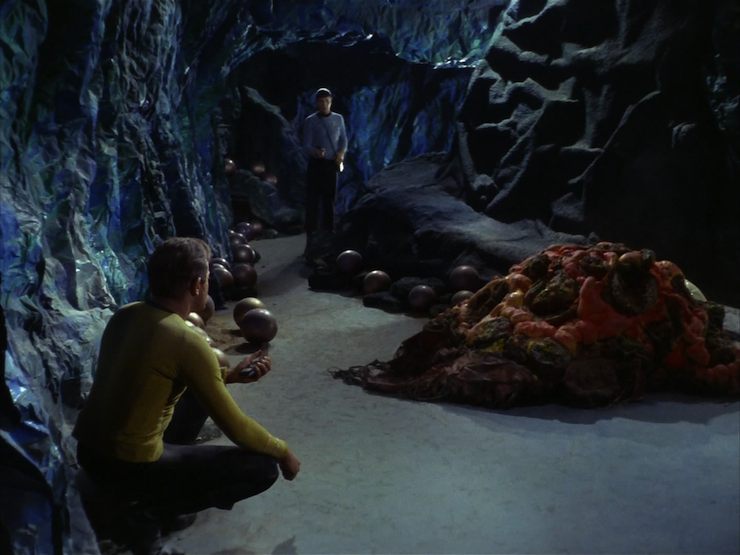
Channel open. “She really liked those ears?
“Captain, the Horta is a remarkably intelligent and sensitive creature with impeccable taste.
“Because she approved of you?”
“Really, Captain, my modesty—”
“Does not bear close examination, Mr. Spock. I suspect you’re becoming more and more human all the time.”
“Captain, I see no reason to stand here and be insulted.”
Kirk expressing surprise that the Horta likes Spock’s ears, Spock unable to hear him over the sound of how awesome he is, Kirk insulting Spock, and Spock proving the insult accurate.
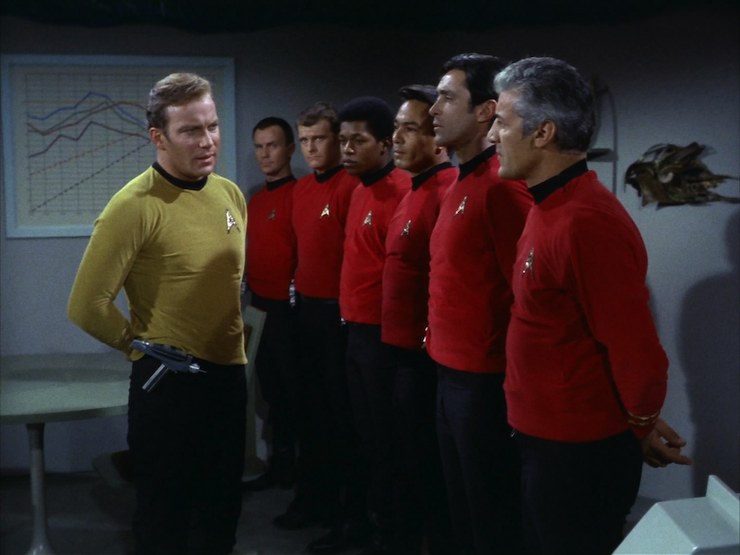
Welcome aboard. Ken Lynch plays Vanderberg, while Brad Weston, Biff Elliot, and George E. Allen play the various personnel on Janus. Enterprise crew includes Barry Russo as Giotto (he’ll be back in “The Ultimate Computer” as Commodore Wesley), Jon Cavett as the guard who’s killed, and recurring regulars DeForest Kelley and James Doohan.
Trivial matters: When this episode first aired, it was announced during the closing credits that Star Trek had been renewed for a second season.
The Horta was created by Janos Prohaska, who created many of the alien costumes for the show. He brought it into Gene Coon’s office, and Coon loved the look and wrote an episode around it.

Giotto has appeared in many many many works of tie-in fiction as the security chief of the Enterprise during the five-year mission (and after, in the case of the New Earth miniseries).
This is another episode that was adapted into fotonovel form, in addition to James Blish’s adaptation in Star Trek 4.
William Shatner learned that his father had died during the filming of this episode. He insisted on getting all his scenes filmed ahead of time so he could go home for the funeral without disrupting the shooting schedule, though the crew offered to shut down production.
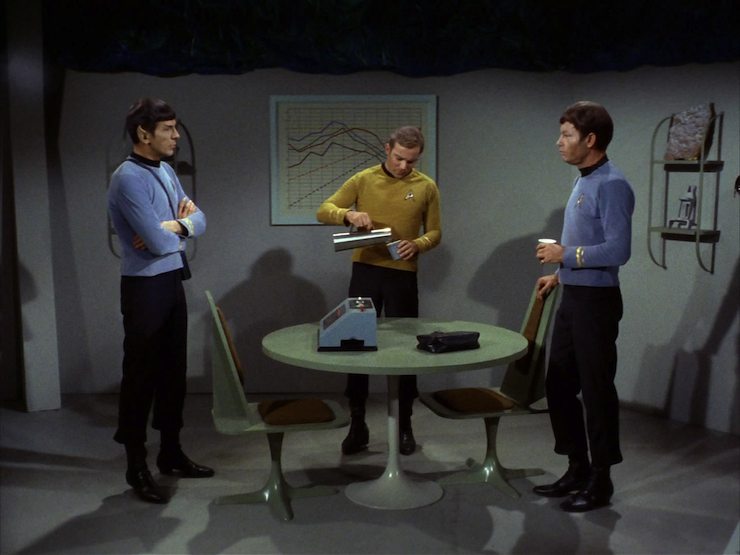
Diane Duane would put one of the Horta babies on the Enterprise as a crew member—Lieutenant Naraht—in several of her novels and comic books. He quickly became a fan favorite. The Horta also play a role in the TOS novel Devil’s Bargain by Tony Daniel. The DS9 novel Devil in the Sky by Greg Cox & John Gregory Betancourt has Deep Space 9 being overrun by baby Hortas. The Borg tried to assimilate another human-Horta mining operation in the 24th century in “A Rolling Stone Gathers No Nanoprobes” by Andy Mangels, Michael A. Martin, Paul Neary, & David Roach, a story in WildStorm’s Star Trek Special comic book.
Pergium would be referenced again in DS9‘s “Prodigal Daughter” and Voyager‘s “Fair Trade.”
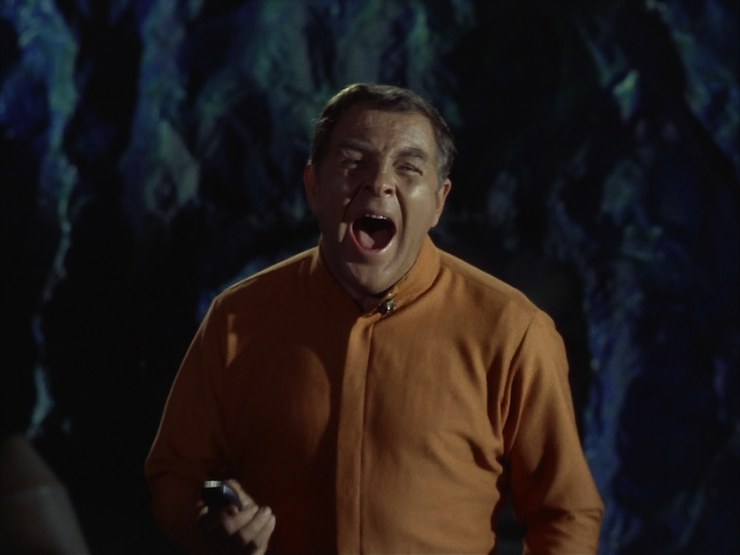
To boldly go. “Pain!” This is, in many ways, the prototypical Star Trek episode. It starts out like every monster movie that’s ever been made, with the suspenseful opening complete with the grisly death of some poor schlub who was already scared to death. Throughout the episode, there’s no doubt in anyone’s mind that this is a monster that has to be killed before more people die.
And then it’s turned on its ear. Such twists are sufficiently commonplace now that it’s easy to forget how radical it was on Star Trek. Just as it was with “Charlie X” and “Arena,” it is here: there are no “monsters,” there are just people, even if those “people” are shaggy silicon-based life forms. Charlie killed a bunch of people, but it’s not because he’s evil, it’s because he’s a kid who was granted absolute power and couldn’t handle it. The Gorn killed a bunch of people, but it’s not because they’re evil, it’s because they were invaded. The Horta killed a bunch of people, but not because she’s evil, it’s because she’s a mother protecting her young.
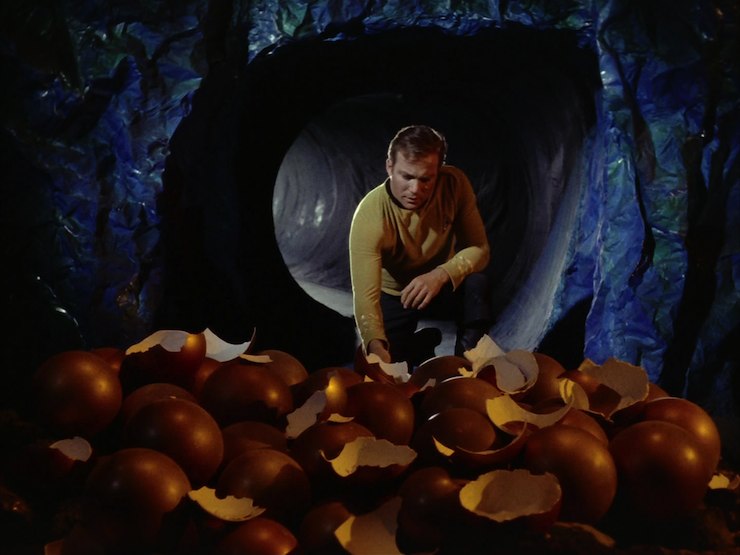
Best of all, though, is that the final message is, once again, compassion. Once the truth comes out, it doesn’t lead to more bloodshed. In the end, the Horta and the humans compromise, both realize what they’ve done, and they work to fix it, just like the humans and the Gorn did, and just like Kirk tried to do with the Thasians. I particularly love the fact that the human viewpoint is not the only legitimate one in the end when Vanderberg says the Horta aren’t bad for being so funny-looking, and Spock reveals that the Horta thought the exact same thing about the humans.
This is a magnificently constructed episode, not only in how well Gene Coon inverts the usual monster-movie tropes, but also in terms of pacing and intensity. Yes, the miners come off as assholes, but fifty of their colleagues have been killed, which kind of strains the politeness muscles—and they relent the moment they realize that they accidentally started this by destroying eggs.
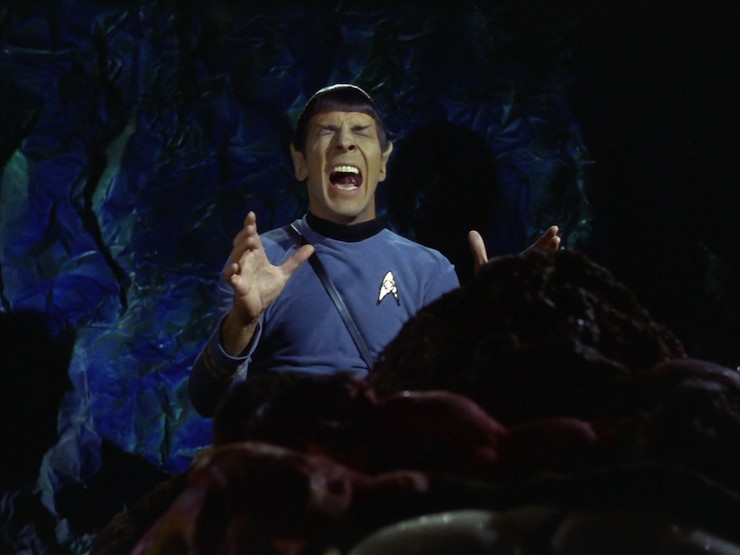
It’s not perfect. The overwhelming white-maleness of the mining crew is irksome, especially given the diversity in Giotto’s security detail. McCoy’s skepticism regarding silicon-based life is a bit too knee-jerk, mostly there only so he can argue with Spock for no reason other than that he’s supposed to argue with Spock. And Spock’s mind-meld with the Horta bleeds over into absurdity more than once, as even Leonard Nimoy’s ability to bring dignity to the undignified is strained past its limit on this one.
But these are minor nits. Overall, one of the greatest Trek episodes, perfectly embodying what makes Trek what it is.
Warp factor rating: 9
Next week: “Errand of Mercy”
Keith R.A. DeCandido will be a guest at RocCon in Rochester, New York this weekend, alongside Star Trek actors Marina Sirtis and J.G. Hertzler, as well as Felix Silla, Ona Grauer, and more actors, and fellow authors Lois Gresh, Jeremy Kahn, and Alec Frasier. Keith will have a table in the dealer room, so come on by and say hi! (And, y’know, buy a book or twelve…)










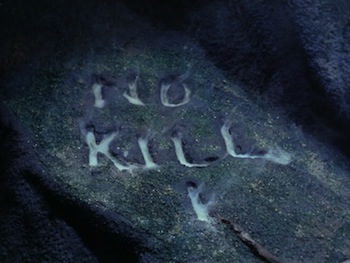
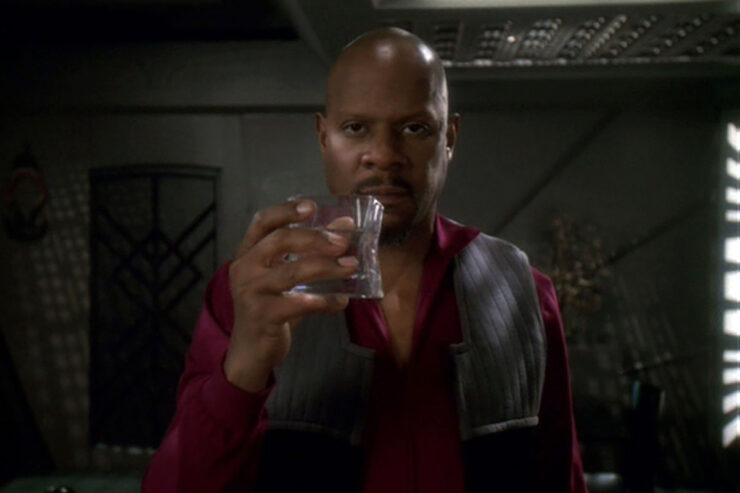
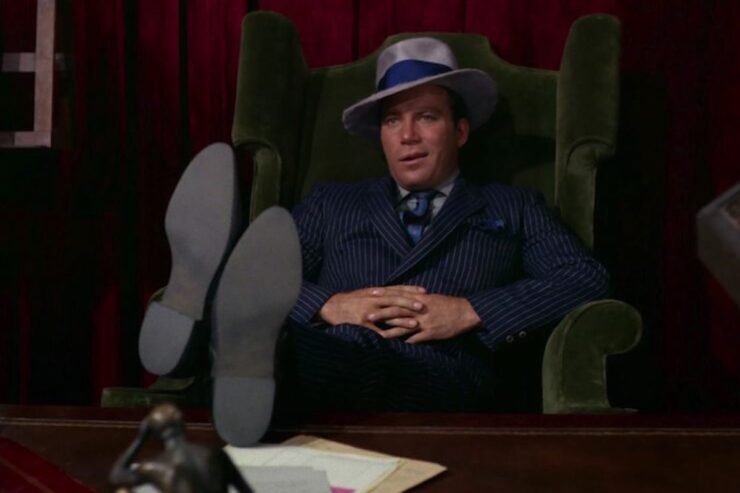
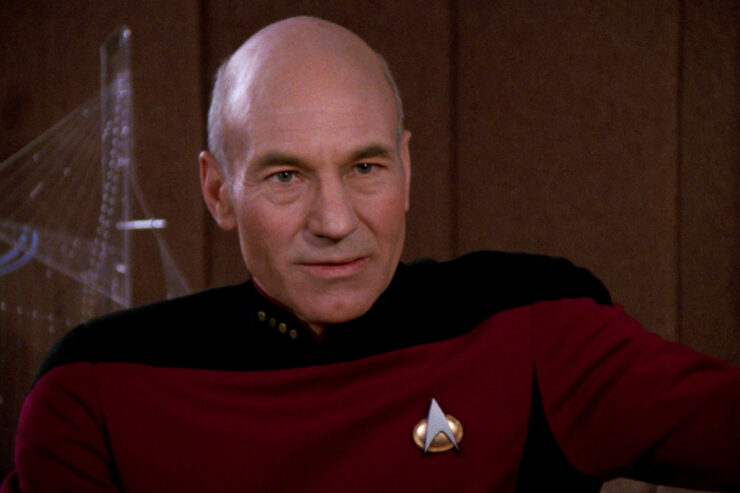
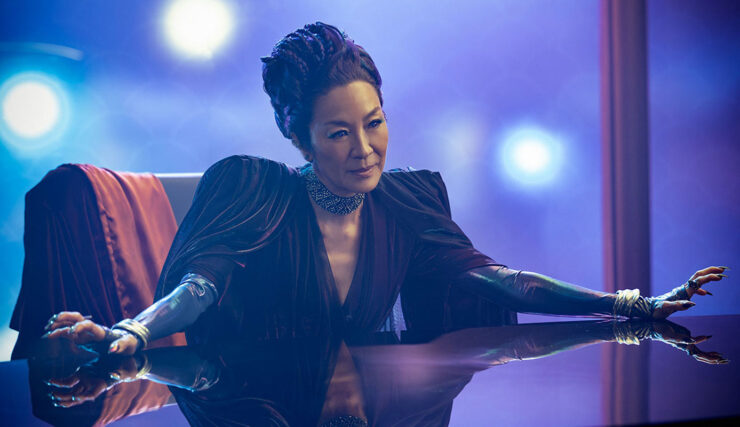
Don’t forget in your trivial matters section that this episode was basically remade in the first season of TNG. I do like this episode better though.
The whole first season of TNG was remakes. But I don’t recall one that could have been a remake of this one. Help?
@2, I attached a link in the TNG. It is called “Home Soil”. Episode 1.17. Not bad, but the Horta was pretty BA in this one..
@2/StrongDreams – I’m guessing the reference is to “Home Soil.”
Edit: Jinx!
Love this ep. Classic Star Trek.
@@.-@, and now I owe you a coke:)
“By golly, Jim, I’m beginning to think I could cure a rainy day.”
Love that line.
Devil in the Dark is my favorite episode of Star Trek. Sooooo pleased to see the high rating here, and I couldn’t agree more with Keith’s opening statement that this is the “prototypical” ST episode. I’ve never forgiven the other rewatchers for both rating this episode a mediocre 4 out of 6…
Not that this is the ultimate judge of an episode’s quality, but the impressions this episode made on me as a kid have stuck with me into adulthood moreso than any other TOS episode. In that same vein, the memory alpha article for this episode mentions that in 1995 Arthur C. Clarke said that DitD was the only episode of TOS that he could recall.
My kids have never seen the episode in full but they love to “play Horta”, which consists of us all crawling around on the floor underneath blankets :D.
I ran across this today while googling the episode: https://en.wikipedia.org/wiki/HORTA_(mining)
Also, I find it very refreshing to finally have an alien that isn’t a) humanoid, b) an energy being of some kind, or c) a god-like being (which is sometimes also an energy being). In fact, I’m racking my brain to think of any other TOS aliens that fit that description and the only other one I can come up with right now is tribbles. Can anyone think of any others?
@8 Myself:
Ok, I did some searching and I came up with a handful more:
–The unicorn dog thing from “The Enemy Within”
–The parasites from “Operation: Annihilate!”
–The medusans from “Is There in Truth No Beauty?”
But still, I’d say that means about 95% of TOS species fit into one of the 3 categories I listed in post # 8. And if we consider just “intelligent” species (meaning, more than just basic animal intelligence), that would presumably just leave the horta and the medusans. And then if we just consider species whose actual physical representation we see on screen, that leaves just the horta. Not sure what my point is here…I guess just that I appreciate the uniqueness of the horta :D.
@8,9 Tholians. The space amoeba from The Immunity Syndrome.
Okay, it has to be said. Gene Coon’s first two solo TOS scripts, “Arena” and “The Devil in the Dark,” are both unforgettable classics and admirable pieces of television. But… they’re the same damn episode. Kirk and Spock arrive on a planet to discover that humans are being killed by a mysterious alien monster, which turns out to be hideous and scary-looking. Kirk is gung-ho to go after it and kill it, Spock urges a more peaceful solution, and Kirk rejects it. Kirk then gets trapped alone with the monster, decides to try Spock’s way after all, and eventually finds out that the whole thing was a misunderstanding, the humans were the unknowing aggressors, and the alien was just defending its people.
Okay, to be fair, they do unfold rather differently in the details. Kirk doesn’t get into an extended desert-survival match with the Horta, and he doesn’t get McCoy to treat an injured Gorn while Spock mind-melds with it. Still, they’re two different iterations of the exact same thematic beats. It’s great that both episodes exist, but maybe it would’ve been better if they were at least further apart.
One other thing that’s always bugged the hell out of me: How in the name of the Great Bird of the Galaxy can a creature that communicates by grinding rock noises “call itself the Horta”? It doesn’t have the vocal machinery to produce those phonemes! This is a common sci-fi trope that drives me crazy — claiming that aliens incapable of phonetic speech give themselves names pronounceable by humans. (See also: Wookiees. Has anyone ever heard Chewbacca emit any sound remotely resembling a K? Or, for that matter, a CH or a B?)
A bit more on the Janos Prohaska story: The Horta costume was originally the “Mikie,” a giant microbe from the Outer Limits episode “The Probe.” It looked rather different in that form, more a blobby starfish. The spore flowers from “This Side of Paradise” were also recycled and modified from an Outer Limits episode, “Specimen: Unknown.”
On silicon life: If it existed, it would actually have to be silicone life, based on the compound of silicon and oxygen and/or carbon. Isaac Asimov’s classic essay “Not As We Know It” explains why — it’s the only form that would be versatile and adaptable enough to serve as a component of life. And silicones are basically rubbery. So a real, silicone-based Horta would actually look a lot like the rubbery costume Prohaska made. Although that doesn’t fit with McCoy treating it as though it were made of rock.
@8/Robert B: The Melkot in Spectre of the Gun. The stone creature in The Savage Curtain, although it had arms and legs, so I guess you could classify it as a humanoid stone creature. (Would you say that the Gorn is humanoid?)
It’s my favourite episode too, although everyone is male (well, except the Horta), so this means I really like the story a lot.
In addition to everything already mentioned, I also love how Kirk and Spock interact here – first, Spock wants to save the Horta (for scientific reasons), and Kirk wants to kill her (to save his people and the miners). As soon as Kirk finds her, and she doesn’t attack immediately, their positions are reversed – now Spock wants Kirk to kill her (because he’s afraid for his friend), and Kirk doesn’t (because he’s a nice guy and doesn’t harm anyone he actually meets eye to eye unless he has to).
@8/Robert B: And then there’s the pipe cleaner worms in Catspaw, and the Kelvans in By Any Other Name have only shape-shifted into their human form and are really “immense beings with a hundred tentacles”. Does that count?
I saw this episode for the first time last month (somehow, I overlooked it for 20 freaking years)! And it deserves the praise it gets. This is as Trekkian as a show could possible get. Here we have these characters making honest mistakes and learning from them. If only everyone in real life could have this optimistic mindset, and be willing to grow past their anger and prejudices.
In retrospect, when I read Shatner’s Star Trek memories, I recall a section where he detailed a supposed rivalry between Roddenberry and Coon. According to Shatner and Jackie Coon, Roddenberry wanted to produce morality-themed episodes while Coon preferred to focus on adventurous comedy outings focusing on the Kirk/Spock/McCoy interplay for laughs and adventure. If anything, Devil in the Dark completely invalidates this part of the book. This episode is proof of a very competent Gene Coon script that plays to Trek’s strenghts as a moral message-based show more than anything else. This was a producer who was more than capable of adhering to what Michael Piller once described as the “Roddenberry’s Box”. This whole alleged dispute for creative control of the show’s direction seemed way too out there to be true.
I was always eager to watch this one to see Leonard’s take on the PAIN line. I knew about that line because of the aforementioned ST Memories book. Definitely not one of Leonard’s better moments (though I mostly blame Gene Coon for this line, more than anything; how many Vulcan-playing actors could make that one work?).
Interestingly, I saw Home Soil decades before this one. I still enjoyed TNG’s take on the idea. Definitely better than season 7’s heavy-handed Force of Nature.
@1: TNG’s Home Soil was written by Robert Sabaroff, who also wrote 1968’s The Immunity Syndrome.
There’s also the Excalbians from “The Savage Curtain,” the Melkot from “Spectre of the Gun,” and the Tholians (sort of).
Plus the ones in TAS, like Arex and M’ress.
@14/Eduardo Jencarelli:
I agree that this is an unsustainable claim, and not only because of this episode (or Arena). Errand of Mercy and Metamorphosis are further examples for anti-violent, “star-trekky” conflict resolutions by Gene Coon. Roddenberry, on the other hand, had Kirk hand out guns in A Private Little War and resolve issues by fighting in The Omega Glory and The Savage Curtain.
Jason: I disagree wholeheartedly that “Home Soil” was in any way, shape, or form a “remake” of this. In the broadest of broad strokes, the plots are similar in structure, but it’s not a remake.
(Indeed, one of my critiques of “Home Soil” was that the Enterprise crew had collective amnesia regarding the Horta when they were shocked at the notion of inorganic life.)
StrongDreams: I disagree with you, too. In fact, I challenge you to back that claim up with a list of every episode and what it’s a remake of. And “The Naked Now” doesn’t count, as it’s a sequel to “The Naked Time,” not a remake (though you can argue that one — it’s a sequel and a remake the same way that Desperado was both a sequel to and a remake of El Mariachi). I’ll give you “Where No One Has Gone Before,” which was an adaptation of Diane Duane’s The Wounded Sky. What else?
—Keith R.A. DeCandido
@11 Christopher: You beat me to it! The only thing that drives me crazy about this otherwise excellent, essence-de-Trek episode, is the claim that the Horta calls her kind Horta. What could that possibly mean? Who ever thought that would sound like it made sense?
But this is indeed a GREAT episode, and my personal favorite. Not only do we find out that people can make terrible mistakes when they’re reacting to another’s aggression…not only do we find out that people *can* actually acknowledge their mistake when it’s pointed out to them and reassess the situation…in addition, the interaction that saves the day is a form of deep empathy. Spock may have been given stupid dialogue for the mind meld, but what he’s doing is seeing the world through the enemy/monster’s eyes, and that’s a bloody difficult thing to do. I like the portrayal of empathy–mentally taking on someone else’s viewpoint–as the way out of deadly conflict. And I like the portrayal of that empathy as difficult, heroic, risky, and costly. Empathy is too often viewed as soft, accommodating, fluffy and feminine. So how can it save the world? How can it be more impressive and effective than violence? The mind meld in this episode works as a dramatization of the power and seriousness of empathy.
I’d also like to mention my favorite recent homage to Devil in the Dark: the conclusion of the Dreamworks movie “Home.” That’s a spoiler, but I hope it doesn’t keep all of you who haven’t seen the movie from watching it as soon as possible, especially if there are young female folks in your life who can watch it with you. You probably would have guessed the enemy’s motivation without my spoiler, but the children will not (unless they’ve watched DitD, too).
@19/Saavik: I agree completely. Empathy has far more power than violence. As I put it in my Age of Ultron review, “Any mindless force of nature can destroy; what enabled humanity to transform the world was our empathy, our ability to bond and work together. That’s real power.” (To refute the idea that Black Widow was somehow a “weaker” character because she was actually feeling and caring about people instead of just shooting and kicking them. I felt that being in touch with her emotions and empathy made her a stronger character.)
@17: I mostly agree, except for A Private Little War, which I’ve just rewatched. That wasn’t as much an oversight in Roddenberry’s part as it was an intentional attempt to challenge the very Trekkian ideals he stood for. That episode gave us a very flawed Jim Kirk, who’d previously spent time on that planet in his youth, and was too invested in his friendship with Tyree, willing to support his cause, and being completely not objective regarding his choice to arm the natives. I felt that episode, much like Gene Coon’s Errand of Mercy, was willing to give us a bigoted Kirk we’d also revisit in Star Trek VI.
krad, If not a straight up remake, then at the very least it is too similar to be coincidental. Both are good episodes, but Home Soil seems to borrow quite a bit from Devil in the Dark.
Jason: Sorry, don’t see it at all. And I write fiction for a living. :)
—Keith R.A. DeCandido
@22/Jason: I don’t think “Home Soil” borrows that much. Sure, they both involve silicon life not being recognized as life at first and being endangered by human efforts, but that’s just the basic premise. It’s not a “remake,” just another take on a particular theme. After all, science fiction is larger than just Star Trek. There have been a lot of SF stories about silicon-based life, and a lot of stories about humans or aliens not recognizing each other as life forms. And as Keith said, “Home Soil” didn’t seem to remember that “The Devil in the Dark” had even happened, treating silicon life as a novelty, so it doesn’t really wash to claim it was borrowing directly from that episode.
As for the two broadly similar stories being “too similar to be coincidental” — Stories are coincidentally similar to each other all the time, to the point that it’s a constant nuisance for writers. It happens so constantly that the number one reason for getting a freelance story pitch rejected is “We’re already doing one like that.” Writers have to try very hard to do stories that haven’t already been done a dozen times if they want to have a chance of selling at all, and despite our best efforts, we still end up duplicating ideas on a regular basis. When I wrote a spec script for TNG, they did a similar plot in an episode that aired the week after I mailed in my script. When I pitched to DS9, one of my rejected pitches was similar to a episode they did the following year — but I’m sure I wasn’t the first one to suggest a similar idea, because hardly anyone ever is.
All stories build from a finite pool of ideas, cultural referents, effective story structures and dynamics, etc. That pool is even narrower when those stories are created for a specific series and its characters and setting. So, no, the similarity isn’t entirely coincidence, but it’s rarely direct, deliberate imitation either. It’s convergent evolution. The same ideas are going to recur from time to time, inevitably. What makes a story original is in what it does with those ideas.
When Roddenberry was talking to critics and news reporters before the show came on, he insisted that TREK wasn’t going to be a standard “monster of the week” show like OUTER LIMITS. The monster that isn’t a monster became a major TREK trope.
For you youngsters who weren’t around for the original series when it first aired, episodes like “A Private Little War” are about Vietnam, not attacks on Roddenberry’s views. TREK got some good shots in on that subject, as well as racism, the Hippie movement, and other silliness of the Sixties.
@25/MByerly: I know that “A Private Little War” is about Vietnam. I don’t think it really works as a Vietnam analogy, but let’s talk about that when the rewatch gets there. That wasn’t my point anyway. I was trying to say that while Roddenberry came up with the original idea behind “Star Trek”, other people wrote all the good episodes, and one of them was Gene Coon. So it’s hard to believe that Coon had wanted to write “adventurous comedy outings” instead.
IMO none of the episodes written by Roddenberry we’ve seen so far has the kind of moral message we get in lots of other episodes, nor do the ones I’ve mentioned above. (By the way, I just looked it up, and the story of “A Private Little War” isn’t even by him. I remembered that incorrectly.) I don’t know why, I’m just wondering.
@21/Eduardo: I don’t think Kirk is behaving so badly in Star Trek VI. OK, there’s his initial “Let them die” line, but then he goes out of his way to make the peace process work, and when he’s put into a Klingon gulag after a highly unfair show trial, he only becomes more dedicated to do so – despite his initial feelings on the subject. He’s quite a nice person in that film.
Glad you mentioned Lt. Naraht, who is really one of the best characters in the expanded Trek universe. Modest, mannerly, smart, brave, and capable — what’s not to like? The scene in The Romulan Way, where he lands in the Romulan Senate hall and they think he’s an Element come to life, is wonderful.
@25/MByerly: To be fair, the “monsters” in The Outer Limits were often misunderstood or sympathetic as well. It would be completely wrong to characterize TOL as a lowbrow, superficial monster show. It was just as much a thoughtful, sophisticated, adult-oriented SF drama as Star Trek was, but was pressured by the network to include a “monster of the week” because that was the stereotype of science fiction that the network heads were laboring under. (Which is the same reason “The Man Trap” was scheduled as the premiere episode of ST — it was the one that best fit the executives’ prejudices of what science fiction was supposed to be.)
I generally know enough to overlook (or at least not take too seriously) flaws in an episode’s plot as long as it doesn’t get too ridiculous. And in general I really like this episode. But I can’t help wondering, if the Hortas eat rock, and they live on a planet that’s largely rock, and there are thousands of them after the eggs hatch, aren’t they eating their own habitat out of existence? How does their food source renew itself? Through their…er…waste products maybe?
@@@@@ 29 richf Hmmm. . . that’s a good point I’d never thought about before. It seems like one possibility is that when they die, they simply become a part of the food supply. McCoy did say that the Horta was literally made of rock — although someone, Christopher Bennett, I think, said above that the science wouldn’t support that statement. Maybe after they die, they somehow decompose back to rock and minerals that can be reused by other Horta.
That also made me realize something else: Shouldn’t there be an entire ecosystem of silicon-based life on Janos VI? How else would the Horta have evolved?
I don’t have much to add here, other than to echo many of the above sentiments that this is a really great episode that showcases the prototypical Trek outlook. It kind of blew my mind when I saw it as a kid.
-Andy
I love this episode, I’ve always thought it a wonderful story. I remember on the video The Twenty-five Year Mission Tour, William Shatner said because of how close and comforting that Leonard Nimoy and Jerry Finnerman were regarding his father’s death that he was able to go to his family warmed and comforted and that made this really his favorite episode. I remember them also talking about after the funeral, when he came back, that Shatner wanted them all to know that he was ok and all was well, so they go to make shots of Kirk watching Spock mind melding, when Nimoy screamed “PAIN!,” Shatner yelled out, “Get that man an aspirin!” Later, in the Mindmeld DVD, Shatner laughed as he mentioned Nimoy didn’t talk to him for weeks after that!
@23 @24, I suppose I should concede since I’m getting beat up by two Trek experts. :) Maybe its because I watched the first season of TOS and then moved on the the first season of TNG. I saw Home Soil very soon after I saw this one. I still think they are very similar, but can see the logic of Christopher’s argument. Keep úp the great work on the recap krad.
Realistically, there should be some kind of food chain and ecosystem. Although, the Horta may also be colonists of some sort or survivors of some long ago disaster, with a simplified–but survivable–ecosystem established. So, the Horta eat, they excrete, other critters/plant equivalents/microbes recycle, and repeat.
Theories on the name:
1) The Horta found a Vulcan or other language term that felt right and gave that as its name. I’m assuming it didn’t translate–and that it’s a real pity Spock doesn’t speak Elvish. That would have been a lot more fun.
2) When Spock mentally hooked up to the Horta, it linked to the language centers of his brain and managed to equate the significant phonemes in Spock’s mind to whatever communication system it uses. It’s a little weird, but so’s telepathy.
3) It picked up an even weirder collection of stuff from Spock. It got the plot of horror story The Horla. According to Wikipedia, Horla could come from “Hor,” meaning outside, and “la,” meaning “there.” Hence, the one from outside.
“Ta” could be from the French “te,” for “you.” Hence, she is seeing herself as they see her in this moment, she is the one outside them, the monster in the dark.
Just to say, while the mining community may lack diversity, that actually plays into what happens. These are all miners. They don’t even have someone with the skills to do more than the most basic repairs on equipment the Horta damages. They need Scotty to do that. Yes, we’re seeing interesting aspects of sex based work divisions in some of the more “frontier” colonies.
But, people with different backgrounds might have started asking different questions about the creature attacking them, and maybe one of them would have made a guess. As far as I can remember, seeing this as a kid, I always thought the spheres were eggs. In the 60’s, it seems a lot more likely that female characters would be expected to make the guess of a mother protecting her young (although that’s my stereotype of a time period’s stereotype of a gender).
Of course, in the 60’s, it’s important that, on one side we have strong, burly, male miners, none of them with families (ie, women and children) to protect. This was a time when there was a strong, cultural perception of men as the protectors and defenders of women and children. Decent guys were expected to protect and assist women and children in trouble (I’m not talking about the application of this in reality or a thousand other gender issues, I’m just pointing out the perception and expectation).
So, for a group of men–particularly a group of men who fit a very masculine image (hard working miners)–to suddenly find out they’d started started this by hurting children and had been fighting a mother protecting her young was a doubly powerful discovery. They might as well turn in their man cards–or fix it by protecting the family they’d attacked.
@34/Ellynne: Lots of theories on the name “Horta” – cool! Your usage of French gave me the idea for another one: There’s a German verb “horten”, meaning “to hoard”. Somebody who hoards stuff would be a “Horter”, with the “er” pronounced as a ahort “a”. I can even imagine a spelling reform in the not-so-far future where all those “er” endings are actually changed to “a”. So, when the Horta introduces herself to Spock, maybe she doesn’t give her species name (which would probably just be “people” anyway) but her current occupation – she’s the one who is amassing eggs and watching over them.
Now I have to find a reason why the Horta “speaks” German…
Oh, and does anybody have an idea why the Horta almost die out every fifty thousand years? Some recurring catastrophe in their solar system? Food shortage?
I always figured it was just some weird quirk that that’s how their species developed.
@@@@@35/JanaJansen If I were to make a guess why the Horta die out, I’d guess that, normally, they have a regular life cycle, eggs being hatched, adults growing up and growing old, etc. Then, the planet goes into whatever condition it is that triggers dormancy. I’m guessing a “winter” equivalent. Eggs are still viable but won’t hatch. The majority of the Horta die off of old age. One, however, goes into a dormant stage. Think of her as a sort of hive mother or queen. I assume she’s in a sleeplike state for most of that time or else her species was the first to invent solitaire.
The 50,000 years seems a bit long, which is why I wonder if this is their home planet or if its changed significantly. Of course, it’s always possible Spock didn’t got all the details right. For example, 50,000 days would have been about 100 years and seems a bit more like something that could evolve naturally, like 17 year locust.
@37/Ellynne: But of course, every planet has its own different “day” and “year” lengths. Some planets have very short years, some have very long days. Venus’s day is actually longer than its year.
Most stars in the galaxy are red dwarfs, which are cooler than the Sun, so a planet would have to be in a closer orbit to be habitable. So most habitable planets in the galaxy would probably have considerably shorter years than Earth does. Then again, Janus VI is not a human-habitable planet, given that it requires a reactor to maintain life support for the miners in its underground caverns. So there’s no telling how far it is from its star. Its year could be 100 Earth days or 75 Earth years for all we know. Though it’s likely that Spock converted the time figure into Federation standard units (i.e. Earth years) for clarity.
This episode came on one afternoon, and at the point where Kirk was standing in front of the Horta with a phaser, my four-year-old asked, “He’s going to shoot him?” And so I told him, “No, you watch, he’s going to try to talk to him instead. Captain Kirk is nice, and he knows to solve his problems with nice words instead of getting mad and hurting people.”
So I’m actually able to successfully use this episode sometimes when he gets upset by saying, “Use your nice Captain Kirk words,” or “Would Captain Kirk hit him?” So that’s a win for Star Trek.
Also, I love that it negates the stereotype that Captain Picard talks and Kirk shoots his way out of things.
@39 Agreed. The more TOS I watch, the more I agree with krad that “rebel Kirk” is a creation of the movies. I’m almost done with season 2 and he is pretty consistently by the book. You steal one starship and your reputation is ruined forever…
I love this episode. I didn’t mind Spock’s dialogue when mind-melded with the Horta. I figure the histrionics were the many emotions the mother Horta was experiencing in finding thousands of her children dead. The white male-ness of the miners always irks me too, but its such a good episode I overlook it. Great story, Star Trek to its core.
@39, 40: I suspect that part of the reason why Kirk is viewed as a rebel and someone who shoots his way out of things is because he’s passionate, we see him fight a lot, and he has ununsual ideas, so he has to be a rebel too. Whereas Spock is always calm and collected, so he has to be by the book, even if he steals a starship right in the first season, and nerve-pinches a guard to sneak out of the ship and do some exploring of his own right in the first film. People expect them to be stock characters, and they’re not, so they don’t see what’s actually there.
It happens in real life too. If someone is a workman who doesn’t talk much and likes to watch TV, people are surprised when he turns out to be a good chess player. If my daughter is good at maths, she can’t be interested in clothes as well. And so on.
@39/crzydroid: Oh, and I forgot to say: That’s such a sweet story about your son. Thanks for posting it!
@42 Its a pity that people have a hard looking past the stock characters. Kirk and Spock are pretty complex characters.
@44/Jason: Yes. They are one of the main reasons why the stories feel real (at least to me), even if the plots are sometimes silly. They could be actual people. (Which is why I tend to get annoyed when Kirk is too good at everything or Spock gets too many superpowers…)
I always felt the name came via telepathy. The Horta may or may not call itself a Horta, but that’s the Federation Standard translation of its name. Like saying 日本人 (nihonjin) vs Japanese. The Japanese people do not call themselves Japanese any more than the Horta calls itself a Horta. But the mind meld included linguistic intercompatibility, so you get it run through the translator.
@46/MeredithP: But that is originally the same word, only distorted by being handed down through several languages and centuries. Whereas the name “Horta” just springs into existence here. I think the best explanation is Ellynne’s first one – it’s some Vulcan term that felt right to the Horta, so that’s how she chose to call herself.
@34 “hors toi” would work better grammatically, and since “toi” is prononced [tua], phonetically as well. But why would Spock use French? The hypothesis of a Vulcan translation seems more likely. Also, the Horla was an intangible creature and is seen as a metaphor for Maupassant’s syphilis, so other Star Trek aliens would match that description better than the horta (although Coon might have used that story for the name.
“This is, in many ways, the prototypical Star Trek episode.”
It’s strange that everyone seems to agree with that, because when I saw it, I thought that Star Trek was doing a classic Doctor Who episode, with the alien ending up being nice and peace being possible (at least in the future or alien planets. Strangely the status quo is never changed for stories set in 1963, even when the monster of the week is completely man made…). Up until Devil in the Dark, I think only The Corbomite Maneuver ended with friendly relations between the aliens and the Federation, and more often than not, the aliens tended to die out before the end of the episode. Here the possibility of cooperation is introduced rather early on, and works. That’s why I really liked that episode (except for the lack of women. I understand that after Mudd’s Women, it makes sense that all miners are men, but couldn’t there at least be a few women among the redshirts?)
“Shore Leave” ended with the hostile force turning out to be friendly and misunderstood, with good relations being achieved at the end. “The Squire of Gothos” ended on a friendly note between Kirk and Trelane’s parents. “The Menagerie” ended on a friendly-ish note with the Talosians, more so than “The Cage” did. “Arena” ended with the implication that peaceful relations would be negotiated. Looking forward to the rest of the season, “Errand of Mercy” ended with a peaceful resolution imposed.
The only ones in the first season with an alien threat dying are “The Man Trap,” “Balance of Terror,” ‘Operation — Annihilate!,” and two where the alien threats were AIs, “What Are Little Girls Made Of?” and “The Return of the Archons.” A few feature human villains dying at the end — “Where No Man Has Gone Before,” “Little Girls” after a fashion, “Dagger of the Mind.” (I don’t count Kodos/Karidian as the villain of “The Conscience of the King,” since his crimes were in the past.)
Other outcomes in S1:
Heroes escape from alien hostiles without killing them: “The Galileo Seven,” “A Taste of Armageddon”
Human (or humanoid) antagonist taken into custody or otherwise imprisoned: “Mudd’s Women,” “Charlie X,” “The Conscience of the King,” “Court Martial,” “The Alternative Factor,” “Space Seed”
Medical crisis or accident with no real antagonist: “The Enemy Within,” “The Naked Time,” “Miri,” “Tomorrow is Yesterday,” “This Side of Paradise,” “The City on the Edge of Forever”
So, in fact, aliens dying at the end was a fairly uncommon outcome. Of the episodes featuring alien life forms or AIs as antagonists, the aliens survive twice as often as they die.
It’s also interesting to note how few of the fatal endings involved direct violence by the heroes against an intelligent, living being — basically only “Where No Man” and “The Man Trap.” Other foes destroyed directly by the heroes were either AIs or nonsentient creatures, and the others destroyed themselves (the Romulans, Dr. Adams).
However, in both cases, the violence was a last resort and self-defense. Kirk tried to be merciful to Mitchell, and it got Kelso killed. McCoy only shot the salt vampire to save Kirk’s life.
—Keith R.A. DeCandido
@50/krad: Yes, good catch. And in neither case was it presented as a triumph — more as a tragedy. (Well, less so in “The Man Trap” than it could’ve been, but it was tinged with regret nonetheless.) Same with the Romulan commander in “Balance of Terror,” and with Korby in “Little Girls” — Chapel mourned his death, even though he’d died long before.
Of course, ’60s TV had pretty strong censorship regarding violence, so I’m not sure Trek was unique in this regard. But other shows got around that censorship in rather more amoral ways. For instance, in Mission: Impossible, the team explicitly wasn’t allowed to assassinate the bad guys (according to the recorded briefing in the pilot, though it was never spelled out again), but what they often did was to trick one bad guy into assassinating another, or frame a bad guy for treason and get him executed. So technically it wasn’t the heroes doing the killing, but only in the most weaselly sense, because they still deliberately arranged to bring about people’s deaths. And of course they did sometimes kill directly in self-defense, like most ’60s action heroes.
I’m afraid I don’t know much about how TV Westerns of the era handled it. I know there must’ve been a lot of gunplay, but I assume the killing was mostly in self-defense on the heroes’ parts. I have the impression that Paladin in Have Gun — Will Travel, on which Roddenberry was story editor, preferred to find nonviolent solutions, but I don’t know for sure. The Lone Ranger never killed, of course, but that was a kids’ show. And then there’s Kung Fu, of course, where the hero was a pacifist and used martial arts in self-defense.
This episode is one of my favorites, and it includes my favorite McCoy “I’m a doctor, not a [BLANK]!” line. I’m glad it’s also the first one. I also didn’t know they announced the renewal of the show during the credits. What a fantastic moment for the fans seeing it for the first time!
And who’s the “Devil” in the dark? The Horta, or the Humans? Depends on the viewpoint, I guess.
@8 – Robert B: Nice to know about the HORTA mining system. And they’re planning on using in space!!! Also love the fact that the alien isn’t humanoind, energy, or god-like.
@24 – Chris “What makes a story original is in what it does with those ideas.”
YES.
@25 – Mbyerly: Us youngsters who weren’t around for TOS’ first airing can read and some of us like history.
@28 – Chris: Having a monster episode as the first aired one was probably a smart move, even if it was prejudiced and unintentional. It may have helped bring in a certain kind of audience that wouldn’t have initially watched a more cerebral show; and then stayed for that anyway. I always say that as a child, what initially attracted me to science fiction were the starships and aliens, but I stayed for the characters and stories that made me think.
@39 – crzydroid: Awesome story. I’ve been watching ST with my son since he was 5 or 6, and now he’s 10 (we’re into DS9 and VOY), and the morals of exploration, diplomacy, and understanding those different to us present in the franchise have always helped me discuss those issues with him.
@42 – JanaJansen: Kirk is also seen as a rebel because he was a “frontier captain”, who had to make his own decisions without getting vidcalls from Starfleet Command every other episode, like Picard. Also, as he led the landing parties, he was more physical than Picard got to be on TNG. But as we’ve seen in this rewatch, Kirk was pretty much by the book.
@52/lordmagnusen: I think the title has a dual meaning. Superficially, it seems to represent the monster in the dark tunnels, but I think it really refers to the fear and hatred that comes from ignorance (being in the dark). Or something like that.
Good point there.
“NO KILL I” always cracks me up. They somehow learned English from the mind-meld, but not basic grammar.
@55/sardinicus: That never bothered me. Lexicon, grammar and alphabet are probably stored differently in the brain, and we don’t know how mind melds work anyway.
<Negation> <verb> <subject> may be Vulcan word order. Who knows? A short mind meld may not be enough for the Horta to tell the different languages in Spock’s brain apart. Maybe Vulcan word order seems more natural to the Horta. Have some imagination!
Hey, I’ll take any excuse to repost the classic “cat fud” FAR SIDE cartoon…………………….
—Keith R.A. DeCandido, who often will refer to what we feed the cats as “cat fud”
Wouldn’t it be more plausible if the dog had hidden a running electric can opener inside the dryer? That would’ve been an irresistible lure even if the cat was ten blocks away.
(And yes, I just asked about the plausibility of a scenario involving a bipedal dog with the ability to write and/or operate a can opener. Don’t judge me.)
What I always admired about this episode is the miners and the Horta’s mutual willingness to move past their guilt and anger and make something positive out of this mess. The fact is nobody is to blame for this tragedy. The Human miners couldn’t possibly have known those odd mineral formations were eggs, but to the Horta it must have been so obvious that her eggs are eggs that she just assumed any intelligent being would have recognized them and the aliens were committing intentional infanticide. So now both sides have to live with the fact they’ve killed innocent intelligent being. Calling it even and starting over was the most enlightened thing to do but it can’t have been easy emotionally.
This is one of the most startrekey Star Trek episodes to ever star trek.
I love this episode. It’s been one of my favorites since childhood, warts and all. The funny thing is that I’ve always felt zero sympathy for Charlie or the Gorn, but I always felt for the Horta, despite the creepy, creepy early scenes.
I’m currently rewatching the show and I’m surprised to see so many female roles of significance in season one. I wonder if the lack of female (and even PoC) roles aside from the titular character in this episode is intentional.
On the one side, you have these rough-neck miners who are blindingly white, monocultural and clueless.
On the other, you have a totally alien “monster” Other who turns out to be not so alien and not so monstrous at the end. In fact, “it” turns out to be a “she” who is just being the best mom she can and defending her children the only way she knows how, with motives so recognizably human they make an entire lynch mob cringe in shame when the boys find out the truth. The show had only about fifty minutes to do this total flip in perception, so I’m guessing the showrunners executed it with as little story noise as they could, even if it does seem a bit convenient that a woman or someone from a different culture among the miners might have caught on to the Horta’s motives, the way Spock (the show’s resident alien) did, long before fifty people died, so the show made sure there weren’t any.
@61/Paula: No, I think it was just the tendency of the era to default to using white and male characters unless there was a reason to make an exception. This was a story about miners, and the assumption was that all miners would be male (see also “Mudd’s Women”). And it’s hardly the only episode of TOS with an all-white guest cast; I’d say that’s more the norm than the exception. Although the Enterprise security team here includes one black actor and one native Hawai’ian actor. (And there’s a female yeoman briefly glimpsed on the bridge at the end.)
@62/Christopher: A lot depended on the individual writer, I think. Gene Coon is my favourite Star Trek writer, but female characters were not his strong suit. What he did pay attention to is the internationality of the crew. He never defaulted to giving all his characters English names. In contrast, Jerome Bixby and David P. Harmon usually had good female characters.
@61, I honestly don’t think a woman would have caught onto the Horta’s motivation any sooner than a man. Also I could be wrong but don’t the miners mention having families?
Um… I would have to contest that the Gorn were invaded. That’s their bullshit rationale for murdering people calling up surrendering! They were invaded as much as Poland invaded Nazi Germany. They weren’t evil because their reasons were the kind of relatable stupidity humanoids are capable of, not the ham-fisted and preachy “peace” mantra the episode feeds. And that’s all she wrote. If they weren’t evil, they could have taken the Cestus III colonists as prisoners, which included women and children and were told it included women and children, and yet they were shown to also be actively conspiring in trying to lure the Enterprise there into an ambush with (what Kirk correctly guesses is) the goal of trying to gather as much information on this new enemy as they can. Hardly the actions of a “civilized” and “not evil” species. Not that the race is, but most likely their government or military is. So yeah, your argument? Bullshit.
@65/Elliot Wilson: The Gorn were not nice, and killed the colonists when they didn’t have to. That makes them ruthless and aggressive; it doesn’t make them “evil”. It’s still possible that they believed they had been invaded, and that they would honour a peace treaty.
IMO the fact that the Gorn are not nice, and that it’s presented as desirable to make peace with them anyway, is a strength of the episode.
The comparison with Germany and Poland doesn’t work because at that time, Europe already consisted of states with clearly defined borders, and everyone knew about them. That’s a completely different situation. In “Arena”, both the Gorn and the Federation expanded into unknown territory and met for the first time.
Yes, the Gorn were ruthless in response to the perceived occupation of Cestus III, but look how ruthless the United States was in response to Pearl Harbor, how unjustly we imprisoned our own citizens of Japanese ancestry out of pure xenophobia. And yet we and Japan went on to become stalwart allies. Just because a nation goes too far in its self-defense at one point in its history, that doesn’t make it “pure evil” for all time. There were mistakes on both sides in “Arena,” and mistakes can be forgiven.
It bothered me that Scotty complained so much about having to recreate a 20-yr old piece of technology but then I remembered his speech to LaForge about maintaining one’s reputation as a miracle worker.
68/andrewfl: Which was a quote of a line from Star Trek IV, for whatever that’s worth.
I thought Shatner did a good job expressing Kirk’s sorrow at losing a guy. I thought it was surprisingly moving and nuanced, behind Spock’s logical back. That said, I’m here because of “The Roddenberry Vaults” collection, and it’s possible that the version there is different somehow. It’s definitely a very nice, clear picture, and the show feels quite different from the time-compressed reruns of my childhood.
And, well, depending on when they shot that part, it probably was a man quite in touch with loss. I know he acted a lot of this episode having just lost his father. Maybe some of the gravity and sincerity on all parts comes from that.
And Spock… Writing this from a time where thousands are dying, watching on a cinematic quality transfer as I was, with the crystal clear sound and all, I didn’t find anything too much about Spock. Even the “Pain” line – it’s shocking, when you don’t know what’s about to happen, and off-putting, and out of character… and I feel like all of it lands. I do feel like I thought it was too much as a kid. I’ve since experienced tremendous, overwhelming darkness, loss, pain. And a much better copy of the episode.
And I bought it all. Everyone in this episode hits it out of the park; even the red shirt deaths feel more real than usual.
@69/jofesh: One movie earlier. The “miracle worker” line came from Star Trek III: The Search for Spock, the opening scene when the Enterprise was returning to Earth. And I always hated it that so many fans (and the writers of “Relics”) took Scotty’s obvious joke in that movie as a truthful statement of his actual practice as an engineer. (Although Lower Decks offered a plausible rationalization of it with its “buffer time” concept.)
This episode is like the embodiment of what Star Trek is all about. The Horta and the miners make nice at the end and become friends (and make the miners money too!). Good stuff.
The miners all being male stands out like a sore thumb. What, no female miners in the future?
Aside from the Enterprise security guard that gets killed without much consideration by anyone, the security team gets a brutal beating by the miners and no mention is made of that either. Just watch one of the security personnel get clubbed over and over!
There’s a weird cut earlier in the episode where Vanderburg is arguing with Kirk and then it cuts immediately to Kirk and Spock and McCoy discussing their situation and Vanderburg is suddenly gone from the room.
McCoy does prove himself to be quite the miracle worker here in treating the wounded Horta and of course this is where his famous catchphrase begins. When he’s treating the Horta, Kelly does make a mispronunciation and says “silicone” instead of “silicon.”
@71/garreth: See comment #11. It’s actually more scientifically plausible if it’s silicone.
@72/CLB: Ah, I see. You’re really versed in your science-literacy!
Other thoughts: The Horta costume design is very alien and impressive, especially for the era in which is was created.
Nimoy’s scenes mind-melding with the Horta are a bit laughable, I’m assuming not intentionally.
Speaking of mind-melds, and basing it off the Picard/Sarek mind-meld where they even state they gain the best parts of each other from the melding — does this mean Spock retains the memories and some essence of the Horta and vice versa. And I may be confusing mind melds with the whole katra-swapping thing that happens at the end of ST II: TWOK and is major story point in ST III: TSFS.
I am late to this discussion. So, please bear with me. As in Obsession, why didn’t Spock and Kirk use the universal translator to converse with the Horta? Especially, once they determined the Horta had a high order of intelligence.
@74/Paladin Burke: Because Gene Coon hadn’t thought up the Universal Translator yet.
Although in-story, it could just be that they weren’t thinking in terms of communication because they saw it as a dangerous predator, so they didn’t bring a translator with them. It was quicker to do a mind meld than to call the ship for a translator to be sent down. We can surmise that the miners later used translators to communicate with the baby Hortas, since I doubt the Hortas communicated entirely by etching letters into rock.
Possibly they need a special kind of Universal Translator because Horta don’t communicate with sound waves?
@76/roxana: The Companion didn’t use sound waves either. That was the whole idea, that the UT read brain waves.
@77/CLB.
Per the Memory Alpha reference, the brain wave thing was not initially established ( perhaps it was by the time of this episode, though I want to say not ); the Roddenberry show-bible entry quoted there specifies “all spoken languages”.
But the point is taken that it’s a plot device, not a coherent technology. . .
@78/sardinicus: But if it was all spoken languages, it wouldn’t have worked for the Horta anyway.
Spock had to tweak the Universal Translator to enable communication with the Companion. And they only tried it when violence didn’t work. I conclude from this that 1. success wasn’t guaranteed, 2. it would have taken too long here, the Horta might have died before Spock came up with the necessary inventions, and 3. the non-enhanced UT probably uses a mixture of sound waves and brain waves. This also makes it a much more plausible device than one that merely uses sound waves, yet can learn any new language in a matter of minutes.
If thermoconcrete is mostly silicone, the emergency shelters that are made from it must seem like bouncy houses.
One thing that hasn’t been mentioned at all yet in the comments is that the credits lists D. C. Fontana as “Script Consultant.” I’m essentially ignorant of what that position entails and was just wondering whether she would have had any influence on the substance and tone of the episode, such that some of the ideas in the story may have come from her.
@82/Larsaf: In modern usage, a script consultant is just what it sounds like, someone whose job it is to provide notes and suggestions on scripts. However, TOS seemed to use the term synonymously with what’s now called a story editor:
https://en.wikipedia.org/wiki/Story_editor
“The story editor has many responsibilities, including finding new script/breakdown writers, developing stories with writers, and ensuring that scripts are suitable for production. The story editor will work closely with the writer on each draft of their story and script, giving the writer feedback on the quality of their work, suggesting improvements that can be made while also ensuring that practical issues, like continuity and correct running time, are adhered to.”
Just to pick a nit, how did a creature from a non-mechanized people know just what piece of equipment to steal?
Good question. Maybe she just got lucky? But the fact she stole the part rather than just destroying it suggests she may have wanted to use it to make a deal. Though how she intended to communicate her conditions… Maybe we just shouldn’t think too much about it
@84/CathWren: I think the intent was to show that the Horta was highly intelligent and not just a mindless monster. As for how she knew to take the circulating pump specifically, I think she could deduce it from observation. The only logical use for a “circulating pump” in a fission reactor is to circulate coolant. Assuming Hortas can sense infrared/heat — which makes sense for a species that lives deep underground in rock without visible light — then she could’ve observed the heat flow in the reactor and deduced that the pump was what kept the core from overheating. She also probably deduced that humans were far more vulnerable to heat and radiation than she was; the cooling mechanism and shielding around the reactor would’ve told her that, and she probably got a sense for how fragile the miners were when she, y’know, killed a few of them.
@86: Good explanation. I’ll buy that in lieu of something simpler. :)
@76 I feel like it could be that the translator couldn’t pick up the Horta’s speech? In later Trek, we do see a few instances of the UT not being able to translate certain languages. Perhaps the Horta’s verbalizations were different enough from humanoid speech that the translator didn’t recognize it as speech, at least initially.
Good review! I love this episode, and always have, since I saw it as a child decades ago. Two small comments:
1. I quite agree with you, Keith, about the lack of diversity among the miners. Not only are there (so far as I could see) no people of color, but there are also no women. This colony has existed for fifty years, or so we are told. That’s no way to run a colony.
2. Rewatching this one last night, I did have to wonder: with what hands did the mama horta abstract the pump? How did she manage to carry it away without burning it to a crisp? And finally, why did she take it, rather than destroying it in the first place? It didn’t seem as though she actually wanted to bargain–not at that point. At that point, she saw the humans as barbaric and hostile and was still attacking them on sight, wasn’t she?
Still, a wonderful, inspirational episode, and quintessential Trek. And yay for Diane Duane! I KNEW she’d put a horta on the bridge!
@89/Mary: “…there are also no women. This colony has existed for fifty years, or so we are told. That’s no way to run a colony.”
The intent was probably that there were family residences somewhere else on the planet, but only the men actually worked in the mines, as in real-life mining towns in that era and throughout history. The matte painting seen out the office window has what seem to be various buildings stretching off into the distance on the far right; maybe those are the residential part of the colony.
“with what hands did the mama horta abstract the pump?”
I think the tendrils around the edges (see the first picture under the “Trivial Matters” heading above) were supposed to be more prehensile than the creature-suit technology was up to depicting.
“How did she manage to carry it away without burning it to a crisp? And finally, why did she take it, rather than destroying it in the first place?”
It’s a cooling pump for a nuclear reactor. It wouldn’t be of any use if it couldn’t survive extreme heat. By the same token, that would probably make it easier to steal than to destroy.
I have just one question: if the Horta is female, why wasn’t she shot with a soft focus lens in all of her close ups like every other woman guest star?
@91/moebius: To preserve the surprise?
@92 Haha, true! But once they revealed it they should have had the screen go all misty while they played Ruth or Andrea’s theme on the soundtrack.
But seriously, speaking of the soundtrack one thing I love about TOS is how any given piece of music fits not only the episode for which it was written but several generic situations as well, allowing the producers to make the ultimate library of stock cues (they also make great ringtones for your phone). “Devil In The Dark” has no original music but every reused cue works perfectly.
@53/ChristopherLBennett: Also, the Horta refers to the human miners as “devils” — probably the most intriguing and powerful possible meaning for the title.
@64/princessroxana: No, I just rewatched the episode and I don’t recall any of the miners mentioning their families. (For all we know, they’re an all-gay mining colony in relationships with each other.)
@75/ChristopherLBennett: And, of course, Naraht uses a translator once he joins Starfleet in the books. (I love his reaching the surface of Romulus “meteorite-style” — i.e., space-diving, using his own body as his heat shield — in “The Romulan Way”, written years before the deleted opening of “Generations” or the space-diving sequence in Star Trek 2009. It may seem obvious to say it, but that Horta has stones.)
@18/krad: A partial list of TNG Season One “remake” episodes, just to give an idea of what may have irritated TOS-fixated fans in 1987-88 — I’m not suggesting that these episodes were actually remakes, or that the similarities are anything but superficial, and there are also probably other possible parallels I’m missing:
“Encounter at Farpoint” (Q storyline) = “The Squire of Gothos”
“The Naked Now” = “The Naked Time”
“Code of Honor” = “Amok Time” (marriage combat)
“The Last Outpost” = “That Which Survives”
“Where No One Has Gone Before” = “Is There In Truth No Beauty?”/The Wounded Sky
“Lonely Among Us” (Antican/Selay storyline) = “Journey to Babel”
“Justice” = “The Apple”
“The Battle” = ?
“Hide and Q” = “The Squire of Gothos”
“Haven” = “Amok Time” (arranged marriage)/”Journey to Babel” (visit by ambassador parent of regular)
“The Big Goodbye” = “A Piece of the Action”
“Datalore” = “What Are Little Girls Made Of?”
“11001001” = ?
“Too Short a Season” = “The Deadly Years” (in reverse)/”The Counter-Clock Incident”
“When the Bough Breaks” = “The Menagerie” (parallel especially vague)
“Home Soil” = “The Devil in the Dark”
“Coming of Age” = ? (Remmick subplot similar to “Regulation 11”, an unproduced TOS story premise by Gene Roddenberry)
“Heart of Glory” = ?
“The Arsenal of Freedom” = ?
“Symbiosis” = “A Taste of Armageddon” (parallel especially vague)
“Skin of Evil” = ?
“We’ll Always Have Paris” = ?
“Conspiracy” = ?
“The Neutral Zone” = “Space Seed”
Once again, I’m not claiming there’s any validity to more than one or two of these parallels, only that this is the kind of thing Trek fans would have been whining about in the late 1980s.
“Devil in the Dark” is a near-perfect episode with an interesting, mysterious plot, a great message and even a “monster” that turns out to be benevolent. The only thing is… there are no females in the entire episode (well, except for the Horta, I guess). No Uhura, no Rand, no female crew, no female security guards, no female miners, no females whatsoever anywhere! Also, near the end of the episode when McCoy angrily tells the “Lieutenant” on his communicator to send down some silicone concrete to treat the Horta, is he talking to Uhura? Seems out of character for the doc to talk like that to her.
The Blish version of this story has some excessive scientific jargony dialogue that was best limited in the televised version, However, Blish’s version also had an interesting element that I wished the broadcast version included. That is, early on, Kirk and Spokc suspected that the killings of the min-ers was sabotage, an “inside job” by one of the other miners, and that the fears of a “monster” was a red herring. I think this subplot would’ve added even more intrigue to the final version.